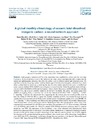Please use this identifier to cite or link to this item:
https://accedacris.ulpgc.es/jspui/handle/10553/74646
| Title: | A global monthly climatology of oceanic total dissolved inorganic carbon: A neural network approach | Authors: | Broullón, Daniel Pérez, Fiz F. Velo, Anton Hoppema, Mario Olsen, Are Takahashi, Taro Key, Robert M. Tanhua, Toste Magdalena Santana-Casiano, J. Kozyr, Alex |
UNESCO Clasification: | 251002 Oceanografía química | Keywords: | Carbon cycle | Issue Date: | 2020 | Project: | Optimizing and Enhancing the Integrated Atlantic Ocean Observing System | Journal: | Earth System Science Data | Abstract: | Anthropogenic emissions of CO2 to the atmosphere have modified the carbon cycle for more than 2 centuries. As the ocean stores most of the carbon on our planet, there is an important task in unraveling the natural and anthropogenic processes that drive the carbon cycle at different spatial and temporal scales. We contribute to this by designing a global monthly climatology of total dissolved inorganic carbon (TCO2), which offers a robust basis in carbon cycle modeling but also for other studies related to this cycle. A feedforward neural network (dubbed NNGv2LDEO) was configured to extract from the Global Ocean Data Analysis Project version 2.2019 (GLODAPv2.2019) and the Lamont-Doherty Earth Observatory (LDEO) datasets the relations between TCO2 and a set of variables related to the former’s variability. The global root mean square error (RMSE) of mapping TCO2 is relatively low for the two datasets (GLODAPv2.2019: 7.2 μmolkg1; LDEO: 11.4 μmolkg1) and also for independent data, suggesting that the network does not overfit possible errors in data. The ability of NNGv2LDEO to capture the monthly variability of TCO2 was testified through the good reproduction of the seasonal cycle in 10 time series stations spread over different regions of the ocean (RMSE: 3.6 to 13.2 μmolkg1). The climatology was obtained by passing through NNGv2LDEO the monthly climatological fields of temperature, salinity, and oxygen from the World Ocean Atlas 2013 and phosphate, nitrate, and silicate computed from a neural network fed with the previous fields. The resolution is 11 in the horizontal, 102 depth levels (0-5500 m), and monthly (0-1500 m) to annual (1550-5500 m) temporal resolution, and it is centered around the year 1995. The uncertainty of the climatology is low when compared with climatological values derived from measured TCO2 in the largest time series stations. Furthermore, a computed climatology of partial pressure of CO2 (pCO2) from a previous climatology of total alkalinity and the present one of TCO2 supports the robustness of this product through the good correlation with a widely used pCO2 climatology (Landschützer et al., 2017). Our TCO2 climatology is distributed through the data repository of the Spanish National Research Council (CSIC; https://doi.org/10.20350/digitalCSIC/10551, Broullón et al., 2020). | URI: | https://accedacris.ulpgc.es/handle/10553/74646 | ISSN: | 1866-3508 | DOI: | 10.5194/essd-12-1725-2020 | Source: | Earth System Science Data [ISSN 1866-3508], v. 12 (3), p. 1725-1743, (Agosto 2020) |
| Appears in Collections: | Artículos |
SCOPUSTM
Citations
36
checked on Jun 8, 2025
WEB OF SCIENCETM
Citations
32
checked on Jun 8, 2025
Page view(s)
167
checked on Jul 12, 2025
Download(s)
165
checked on Jul 12, 2025
Google ScholarTM
Check
Altmetric
Share
Export metadata
Items in accedaCRIS are protected by copyright, with all rights reserved, unless otherwise indicated.
